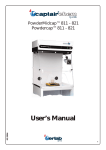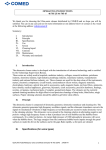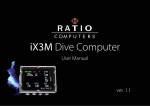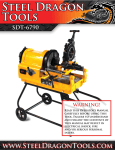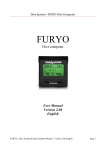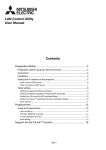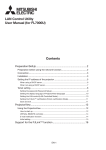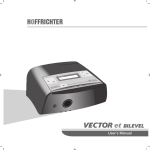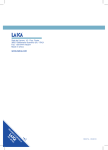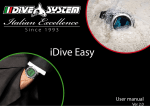Download USE
Transcript
X-Tech CLV User Manual English Sommary 03. Use 04. Maintenance 05. Caution 06. Technical specifications 08. Cold water use (<10 °C) 09. Warranty 2 Congratulations on your recent purchase of a Dive System regulator and thank you for tour support. Dive System regulators, manufactured with corrosion resistant materials, use the most modern techniques for optimum air delivery and comfort during the dive. Diving regulators deliver air at current ambient pressure upon demand. The use of regulators requires proper training by a certified agency. IMPORTANT: The use of regulators in sport diving is limited to depth of 120 feet / 40 meters. This depth limit can be extended to 150 feet / 50 meters, for professional use. To exceed these limits may lead to high risk situations (narcosis, etc..). USE A regulator must be used in combination with a pressure gauge. The regulator can mounted on a diving cylinder in either of two configurations : Yoke connector (up to 3300 psi / 230 bars) ISO/DIS 1209-1 : 1998 230 and 300 bars DIN connector (up to 3300 or 4400 psi) ISO/DIS 1209-2 & 3 : 1998 Gli erogatori DiveSystem sono equipaggiati con porte di bassa pressione (LP) da 3/8” e porte di alta pressione (HP) da 7/16”. Le fruste LP di jacket e muta stagna possono essere connesse con le porte LP disponibili, la frusta HP del manometro deve essere connessa ad una porta HP. Per un livello superiore di sicurezza è consigliabile l’uso di una bombola con doppio connettore e l’uso di un erogatore indipendente di backup. Dive System regulators are equipped with low pressure (LP) ports of 3/8” and high pressure (HP) ports of 7/16”. Buoyancy compensators LP hose and drysuit hose can be installed on available LP ports. The pressure gauge needs to be installed on the HP port. For added security, the use of a cylinder with dual outlet valve (Y-valve) will allow for a secondary back-up regulator. WARNING: This regulator, complying with EN 250, is not intended for more than one diver to breathe from at the same time. If this regulator is configured and used by more than one diver at the same time, then cold water and breathing performance may not fulfill the requirements of EN 250. RECOMMENDATIONS: A regulator will offer optimum performance in the following situations : Water temperature between 10 °C (50 °F) to 35 °C (95° F). Air supply must be conform to the breathing air standard. 3 MAINTENANCE BEFORE THE DIVE: Please note that the procedures outlined below do not apply to cold water regulators which requires specific preparation and use. • Remove the dust protector and install the first stage on the valve by tightening the yoke screw or DIN kit (do not over tighten). • Open the valve completely and check the cylinder pressure on the pres- sure gauge. • • Purge the second stage by depressing the purge button for a few seconds to ensure proper air delivery. Put the 2nd stage in Dive mode Venturi + and Sens. Adjust. knob open • Take several inhalations on the second stage while on the surface before starting your dive. AFTER THE DIVE: • Close the cylinder completely (turn off the valve). • Remove any residual air from the regulator by purging the second stage (depress the purge button). • Remove the regulator by unscrewing the yoke DIN connector. • After drying the dust cap, replace it over the yoke retainer WARNING: Do not blow high pressure air directly on the regulator filter to prevent humidity from entering the high pressure chamber. 4 CAUTION • Do not leave your regulator exposed to direct sunlight if possible. • Do not use the regulator first stage as a handle to carry the cylinder. • After every dive quickly remove the regulator from the cylinder to pre- serve it from any shock damage. • In every case always handle your with care. CLEANING After the dive your regulator should be cleaned with fresh water. Before rinsing your first stage, make sure the dust cap is in place. Dive System recommends the use of cleaning/desinfection product (cold process) for the destruction of the germs on regulators. STORAGE After the regulator has been rinsed and dried, store it if possible by hanging it by the first stage yoke, away from heat and direct sunlight. When storing it for an extended period of time, select a dry cool, clean place, and apply to the hose and first stage silicone spray approved for use with diving equipment. CHECK-UP AND REPAIRS Regulator will provide optimum performance only if used properly and inspected regularly. Normal wear parts such as diaphragm, seat, exhaust valve, o’rings, mouthpiece must be inspected and changed regularly. Every year, preferably before the start of the diving season, the regulator must be taken to a Dive System authorized technician for annual service. 5 Technical specifications All Dive System regulators meet the European standard EN 250 - 2000 (Air) or EN 13949-2004 (Nitrox). Specifications: DIN 300 bars - 4400 psi (Réf. : 316 060) I° Stage CLV The balanced diaphragm first stage reduces the high pressure air in the cylinder to an adjustable intermediate pressure of 9,5 bars (145 PSI) above ambient pressure. The first stage is balanced and delivers air at constant pressure even as the pressure decrease inside the cylinder. A low pressure hose links the first to the second stage. The first stage features four 3/8” LP ports and two 7/16” HP ports. II° Stage X-TECH The second stage is a pneumatically balanced second stage, witch offers optimum ease of breathing. An additional adjustment allow the diver to fine tune the Venturi effect to the dive / diver conditions. A specially designed front cover offers maximum protection to the diaphragm and minimizes the side effect of strong currents. The second stage come from factory with adjustment knob and lever in the minus position. Venturi lever Located on the side of the second stage Housing, enables the diver to control the inhalation Venturi effect. When on the + position, the diver get maximum Venturi assistance upon initial inhalation, the air flow is maintained without additional effort. Important: On the surface to avoid any free flow resulting from surface waves and / or sudden entry in the water , the diver should keep the lever pushed towards the front in the - minus position. This position should be maintained whenever the second stage is used as an octopus for a safe second stage. At the beginning of the dive, the diver should push the Venturi lever in the + / plus position, to obtain optimum breathing characteristics. The + / plus position is the “dive mode” position. 6 Inhalation Resistance This knob, located on the left hand side of the hosing, allows to adjust the resistance on the spring and thereby to alter the initial breathing resistance. The diver can choose any position between the minimum (turned completely counter clock wise) and the maximum (turned completely clock wise) depending on the conditions. turning the knob clockwise will increase the inhalation resistance, turning it counter clockwise will decrease the inhalation resistance. When the inhalation resistance knob is in the minimum position, there may be a light free flow. If this is the case, slightly turn the knob clockwise until the air flow stops. Orhave your regulator checked by an authorized Dive System dealer. Note The first stage 3/8” LP ports can accommodate the safe second stage octopus and the buoyancy compensator LP hose and / or drysuit inflator hose. On the 7/16” HP port, install a pressure gauge to check air supply during the dive. Venturi lever Inhalation Resistance 7 COLD WATER USE Use of regulators in water temperature colder than 50 F / 10° C, requires special equipment and precautions. The X-TECH CLV should be used in cold water diving. • Make sure that your air supply meet the EN 12021 quality norm require- ments. • Use a cylinder with a dual outlet Y-valve and two independent breathing system outfitted for cold water use. • Do not expose the regulator to cold air (colder than 32 °F / 10°C). • Place the regulator first stage in the cold water to bring its temperature up before use. • Do not purge the second stage outside the water to avoid freezing inci- dence. • During the dive : do not purge unnecessary demands on your regulator, i.e. avoid using all at once the regulator, the octopus, the BC power inflator and the dry-suit valve. • Do not purge the regulator unless required. • If the regulator were to freeze up accidentally and therefore free flow, switch to your second breathing system and abort the dive. WARNING Cold water diving requires special equipment and training. Failure to follow the above instructions and recommendations can result in serious injury or death. Certified instruction should be received and completed for cold water and ice diving from a certified instructor by a recognized training agency prior to attempting any cold water or ice diving. 8 Warranty All our products are guaranteed according to the current laws in the country of purchase from the date of purchase by the user, in compliance with the use it was developped for. The warranty covers parts recognized as defective by our technical services, and manufacturing and material defects with the exception of parts worn by use. The warranty does not cover damages caused by rough handling, dropping, or incorrect use at the surface or while diving. The warranty does not cover defects in appearance or function that are due to normal wear of the product or to its ageing. The warranty shall not be valid if the product was not cared for or used as stipulated in the user guide or if the product was opened or maintenanced by a person lacking adequate technical training and not using the proper maintenance equipment. The responsibility resulting from the sale of our products is limited exclusively to the above warranty and excludes all possibility of recourse to penalties or damages. To benefit from the present warranty, the product must be returned along with proof of purchase. 9









